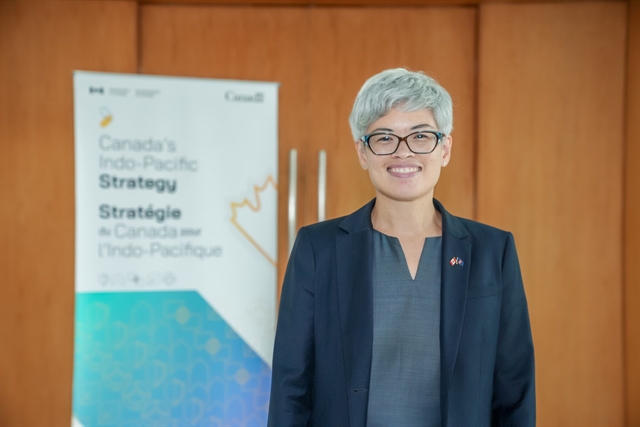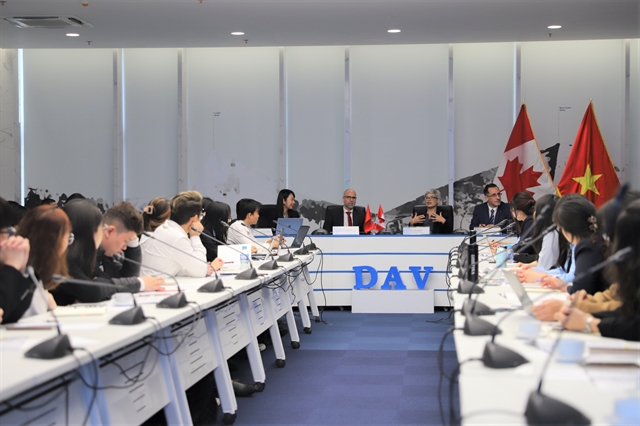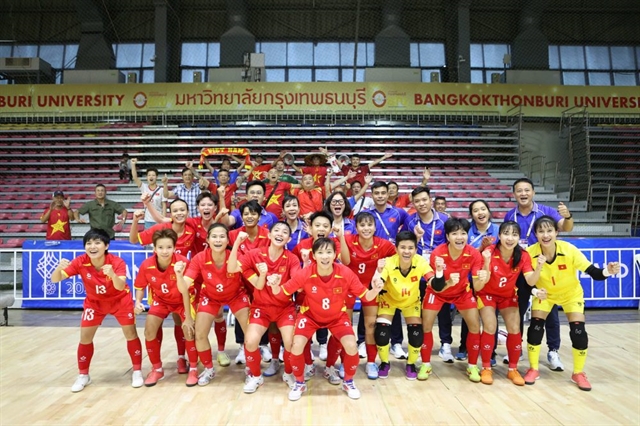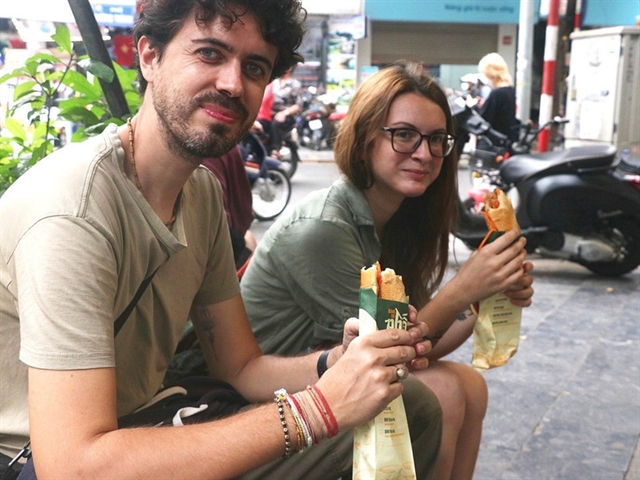 Politics & Law
Politics & Law

 |
| Chargé d’Affaires of Canadian Mission to ASEAN Vicky Singmin. Photo courtesy of the Canadian Embassy in Vietnam. |
In a recent interview with Việt Nam News reporter Vân Nguyễn, Chargé d’Affaires of Canada Mission to ASEAN Vicky Singmin, talks about the role of ASEAN in its newly released Indo-Pacific Strategy and potentials for further cooperation in trade and security as well as the progress of the establishment of the Strategic Partnership between the two regions.
Last November, Canada released its 10-year Indo-Pacific Strategy. It has committed US$2.2 billion to realise its engagement initiatives with Indo-Pacific nations, the largest commitment it has made so far. Why is Indo-Pacific so important? And why is the strategy released now?
Canada’s Indo-Pacific Strategy released last year, is a long-term, comprehensive and very ambitious commitment of the country to stay in the region. Regarding the funding you mentioned, the first couple of billion dollars is there to finance the first five years of the strategy and there will be more to come. We, as government officials, will ensure that we go back to request additional funding.
Regarding the timing of the strategy release, I think it is a strategy that has been given a lot of thought and consideration. There is a recognition of the importance of the region because of the opportunities for economic growth and the importance of the stability of that region and for global stability as well. The Indo-Pacific Strategy is an opportunity to demonstrate our commitment by showing the resources that we are putting to support different initiatives and increase our presence in the region.
ASEAN is front and centre to the strategy because we recognise how important the role of ASEAN is in contributing to the peace and prosperity of the region. It can be seen in the strategy that partnership is one of the key areas of engagement and one of those partnership areas is with ASEAN. We are pleased that we got the commitment to leaders to establish a strategic partnership between Canada and ASEAN and this goes hand in hand with Indo Pacific strategy with our intention to move forward and support the ASEAN Outlook on the Indo Pacific.
The Indo-Pacific region consists of ASEAN and some of the world’s major economies like India, Australia, New Zealand, South Korea, how does Canada view the role of ASEAN in the strategy and how does it view the region’s centrality and neutrality in Canada’s Indo-Pacific Strategy?
ASEAN is playing a central role in the region and it is part of our new Pacific strategy.
It can be seen that the five areas of Canada's Indo-Pacific Strategy align fully with the work that ASEAN is doing. The outlined initiatives show our support for different pillars of ASEAN.
With regards to economic pillar, our ASEAN-Canada Free Trade Agreement is in the middle of negotiating. It is obviously a key way in which we can expand our economic relations with ASEAN and support their central role. There are also other initiatives in terms of the trade gateway which we are looking to establish.
On the security side, there is a couple areas in terms of countering transnational crime, supporting anti-terrorism efforts and working through mechanisms like the ASEAN Regional Forum.
This is work that Canada is doing but we are doing it in a way that supports ASEAN centrality and in a way that reinforces ASEAN mechanisms and therefore supporting and reinforcing ASEAN centrality.
 |
| Chargé d’Affaires of Canadian Mission to ASEAN Vicky Singmin, Ambassador of Canada to Vietnam Shawn Steil (second, left) and Dr. Stephen R Nagy, a Canadian scholar talk with students at the Diplomatic Academy of Vietnam on Friday in Hà Nội. Photo courtesy of the embassy |
So far ASEAN has established dialogue partnerships with Australia, Canada, China, EU, India, Japan, New Zealand, South Korea, Russia, UK and US. Many of them are members of RCEP, the world largest trade pact. With negotiation of a FTA with ASEAN still underway, how will Canada work to boost trade with the bloc?
The ASEAN-Canada FTA is our principal ingredient of tool and agreement that we are negotiating because we see that is so essential to advancing the economic relationship between our two regions.
When we first started talking about the FTA, there was a significant amount of work that was undertaken, including a feasibility study to look specifically at the benefits and advantages of this. I think by taking that thoughtful approach, one of the conclusions was there would be an estimated US$6 billion in increase in trade for the region.
We have taken an approach to make sure there was good agreement by both ASEAN and Canada. In 2021, on the margins of our ASEAN Economic Ministers Meeting, there was agreement to launch the negotiations of the FTA.
Regarding non-traditional security threats, including natural disasters and climate change especially when the Indo-Pacific accounts for 50 per cent of greenhouse emissions, what are the opportunities for Canadian engagement in this aspect?
Engagement in non-traditional security areas is quite important, whether it is natural disasters, climate change and also health security. With the pandemic, that was a realisation of the importance of health, and an area where we are continuing to engage. Canada has a long-standing mitigation of biological threats programme, which has been ongoing for a decade. And this is an initiative to build the capacity of ASEAN member states to increase their ability to detect biological threats. During the pandemic, that existing program was able to adjust and move resources to specifically focus on COVID-19 and increase the capacity of ASEAN member states. And at the same time, we leverage the same initiative to be able to provide a very sizeable in kind contribution of personal protective equipment to ASEAN member states. And right now as we are thankfully coming out of the pandemic, we are looking again once more at this initiative and making sure that it is flexible and we will use the funding to provide investments in the ASEAN Centre for Public Health Emergencies and Emerging Diseases.
That reflects the way we work and our investment in non-traditional security areas. Regarding climate change, there is a number of areas that fit into that including advancing international clean technology, disaster risk and resilience, supporting shared ocean funds, these are all elements that will contribute to addressing the issues associated with with climate change.
With the release of the Indo-Pacific Strategy, Canada aims to increase its presence in the region. What are the opportunities for Việt Nam and what should it do to maximise the potentials?
Looking at Việt Nam from the perspective of ASEAN, I think it is very important that Canada continues to seek opportunities to engage with all member states and that includes Việt Nam. It is part of an ongoing conversation to look at opportunities that make the most sense.
The ASEAN Centre for Public Health and Emerging Diseases where Việt Nam is taking leadership along with Indonesia and Thailand is an example. That is an area where we partner. There are many opportunities we have partnered. The Indo-Pacific Strategy itself provides more and more opportunities as we continue to roll out these initiatives to be able to work with key ASEAN member states.
Women, peace and security is also an area where we have substantial capacity at the global level and regional level and we also make investments at the national level. The Vietnamese government has also committed to develop a national plan of action so this is another area where Canada and Việt Nam both have an interest but also in the ASEAN context. So it ties together very nicely. This is a conversation that will continue as we roll out the Indo Pacific strategy and move forward under our strategic partnership relationship with ASEAN.
With regards to the Strategic Partnership between ASEAN and Canada, what is the progress so far and when is it expected to be established?
ASEAN and Canadian leaders committed to establish a strategic partnership between the two regions during the Commemorative Summit between Canada and ASEAN last year. Our Prime Minister Justin Trudeau was was there and was very pleased that this agreement was reached.
The agreement was a commitment to establish the partnership and go through the process as quickly as possible. It is very much our focus this year to be able to establish this strategic partnership. And we see the Indo-Pacific Strategy as a key development that allows us to move our partnership together in that strategic way. — VNS




